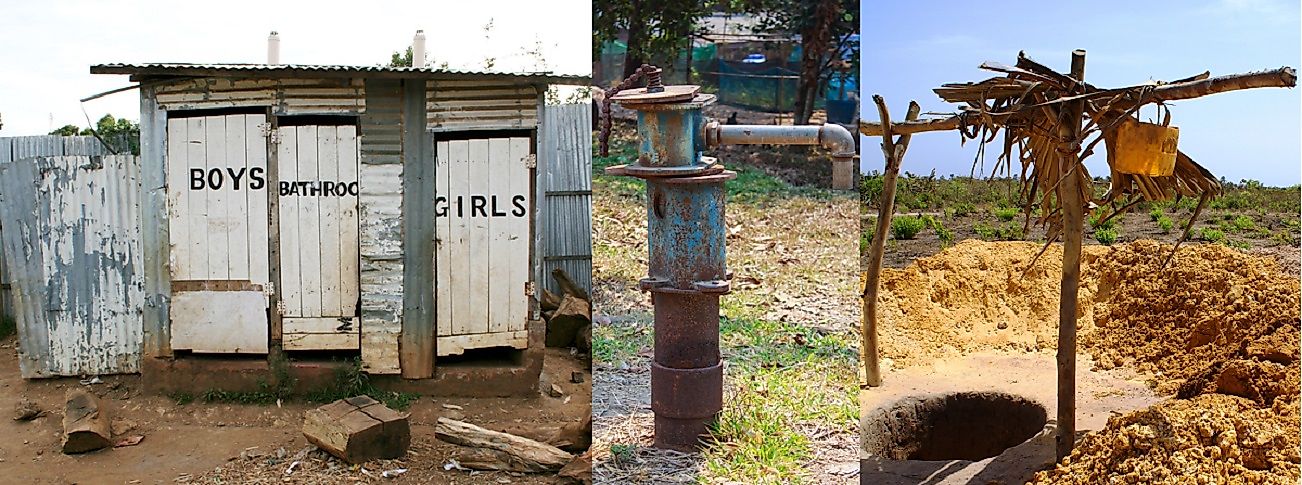Countries Where Urban Populations Lack Access to Sanitary Facilities

Several countries across the world have a greater proportion of the population who do not have access to improved sanitation facilities. Proper sanitation facilities ensure that the human population is separated from their waste. Some of the improved facilities include piped sewer systems, pit latrines, composite toilets, and proper waste disposal sites. Sanitation is essential to the improved quality of life. Access to sanitation facilities is a measure of a country’s progress in the fight against diseases and poverty. Proper sanitation facilities are basic human rights for every single person irrespective of the nation according to the United Nations. The majority of third world countries’ urban population has little or no access to improved sanitation. Some of these countries include South Sudan, Madagascar, the Republic of the Congo, Ghana, Sierra Leone, Togo, Ethiopia, Liberia, Uganda, and the Democratic Republic of the Congo (DRC).
Urban Populations With Low Access to Improved Sanitation Facilities
South Sudan
Only 15% of South Sudan households use a safe means of human waste disposal while only 55% of the population has access to clean drinking water. Sanitation is even worse in urban areas of Juba where only 16% of the population can access to quality sanitation. The dismal figures in urban areas are due to overcrowding and the constant conflict. Poor sanitation is attributed to lack of proper government policy on water, sanitation, and waste disposal. The state of poor sanitation in South Sudanese towns has exposed the majority of the population to health risks such as internal parasites infections, diarrhea, and respiratory diseases.
Madagascar
Madagascar’s urban area sanitation management is not well defined as such. In fact, even the established waste management body, SAMVA, is only operational in one urban town. Due to poor sanitation management and lack of established policy on sanitation and water, only 18% of urban population and 6% of the rural population can access clean water and quality sanitation facilities. The sanitation management is entrusted to the communes who maintain the sanitation facilities. However, these communes do not have sufficient funds for waste management.
Republic of the Congo
The Republic of the Congo is one of the poorest countries in the world ranked position 175 out of 177 according to UN data. Access to sanitation and clean water is constrained by improper coordination by water authorities in the Republic of the Congo. The proportion of the peri-urban and semi-urban population who has access to safe drinking water and quality sanitation is only 20% of the urban population. The low access to quality sanitation is due to the poor funding of the water and sanitation sector and poor infrastructure in the country. International donors such as World Bank, European Union, and Africa Development Bank are working together with the Republic of the Congo's government to improve sanitation in the country.
Ghana
Ghana has set aggressive policies to meet national goals on water and sanitation facilities. Most of the sanitation improvement strategies aim at improving the sanitation of the urban areas such as Kumasi where access to improved sanitation facilities is still at 20%. The low access has been attributed to lack of funding and capacity building in Ghana. Most of the efforts have been directed towards improving access to water at the expense of sanitation facilities.
Making Progress Towards Needed Improvements
To increase the access improved sanitation facilities for the urban population, the governments have deliberately allocated funds towards improving and providing sanitation facilities. The Millennium Development Goals set by the United Nations have been used as a benchmark by most countries for the provision of these services. The governments have also partnered with donor organizations such as World Bank, Africa Development Bank, and other developed nations to improve their sanitation facilities.
Countries Whose Urban Population Has Lowest Access to Improved Sanitation Facilities
| Rank | Country | % Of Urban Population With Access To Improved Sanitation Facilities |
|---|---|---|
| 1 | South Sudan | 16 |
| 2 | Madagascar | 18 |
| 3 | Congo, Rep. | 20 |
| 4 | Ghana | 20 |
| 5 | Sierra Leone | 23 |
| 6 | Togo | 25 |
| 7 | Ethiopia | 27 |
| 8 | Liberia | 28 |
| 9 | Uganda | 29 |
| 10 | Congo, Dem. Rep. | 29 |











